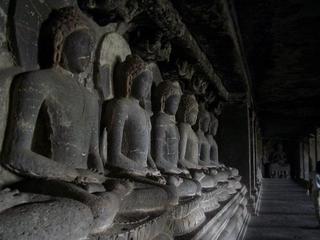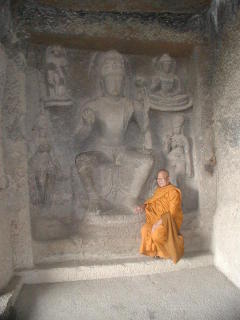
The
The Ellora temple caves are used for worship by different religions, namely Buddhism, Hinduism, and Jainism. These caves are a mile and a quarter long. They are located about eighteen and a half miles from the city of
The Ellora caves, which date from the period 9 to 12 A.D., were constructed later than the
The most beautiful of the Ellora caves is the tenth. It is two stories high with a pagoda inside. The top floor has a large arched balcony extending outwards. There are stone carvings of hovering devas on the exterior face of the cave. The ceiling is a Sanchi-style dome. In the stupa there is a large Buddha image.
The eleventh and twelfth caves, which are considered to be more important than the other caves, are three stories high. Each story consists of a large residence hall (vihara) that the monks used. The monks’ cells extend off from the halls. The viharas are decorated with large columns and include balconies. Each top story, which contains many Buddha images lined up in a row, has a large Buddha sculpture. The fourth cave is currently used for Dhamma study, and the twelfth for merit ceremonies and as a monks’ quarters.
The seventeenth cave was the Hindu cave. The Hindu people wanted their caves to be a treasure of Hindu religion. They constructed caves thirteen through twenty-nine.
It was well known that the sixteenth cave, the Kailash cave, was the most beautiful of all the Ellora caves. This cave was carved from top to bottom out of a mountain. Altogether the stone that was removed weighed about 200,000 tons. The stone was carved into a very large and very beautiful Hindu-style temple. Around the temple walls and doors there are various forms of the Hindu god (tavathas) with his consort. Inside what was the monks’ residence is a large Shiva-lincum (phallus). On the ceiling of the temple is a carving of a lotus. Many Hindu people come here to worship. When they enter they feel that they are connected with their ancestors. Because the temple cave is so enormous, in every direction there are stone carvings of Hindu tavathas miles long.
When the Jains were in power, they built caves that modeled the caves the Buddhists and Hindus had built. This is especially true of the thirty-second Jain cave. This temple cave contains a stone carving of Mahavira sitting in the meditation position under a banyan tree. Another carving depicts a naked male standing with a vine wrapped around his arms and legs. However, all thirty-four caves have carving of devas at the ceiling angles, as well as carvings covering the columns with large lotus petals at the capitals of the columns.




1 comment:
Great pictures I have ever got ! And this is a very good news.
Yes, I wish I got the opportunity to go there.
Keep updating.
Nareth from Cambodia
Post a Comment